No-yeast kefir bread is a three ingredient loaf that’s simply delicious, and you don’t even need to knead it! Slowly raised overnight by milk kefir, it is sweet, soft and aromatic, with a note of sourness. An ideal alternative to sourdough!
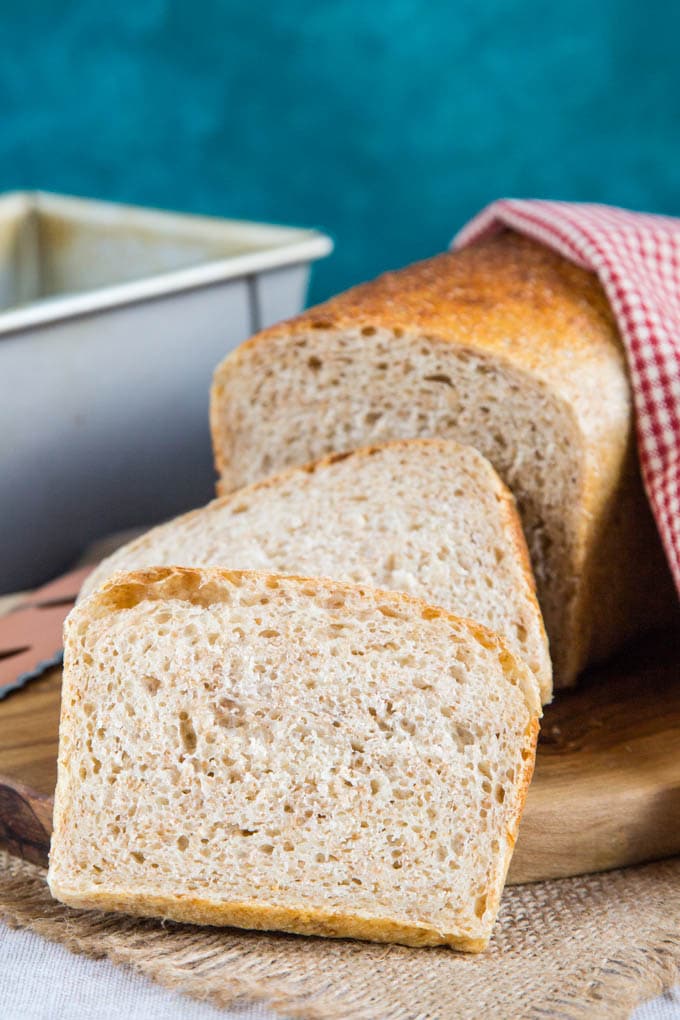
Milk Kefir Bread – No Yeast, No Knead!
This is a tasty soft white bread that uses the yeast found in home-made kefir (cultured fermented milk) to give a long, slow rise to dough. The milk kefir gives a hint of sourness to the bread and you don’t need any additional yeast. I love it toasted, with a generous smear of salty butter on top and maybe a little homemade jam.
Why Make Kefir Bread?
- Tasty! It’s a soft and delicious loaf with a hint of sweetness.
- It’s easy! The long rise means that the gluten develops naturally. No kneading required! It isn’t the quickest loaf, though, and rising times will vary.
- No yeast or sourdough starter needed.
- It’s different. I love experimenting with different recipes, and this slow rise loaf made without commercial yeast or sourdough starter is fun to make.
Can I Make Kefir Raised Bread with Ready-Made Kefir?
I’m afraid not, no. Bottled kefir from the supermarket is too filtered and refined, and doesn’t contain the microscopic pieces of yeast found in home-made kefir. It’s this yeast that raises the dough. Making your own milk is easy and economical though, and finding the necessary grains is straightforward.
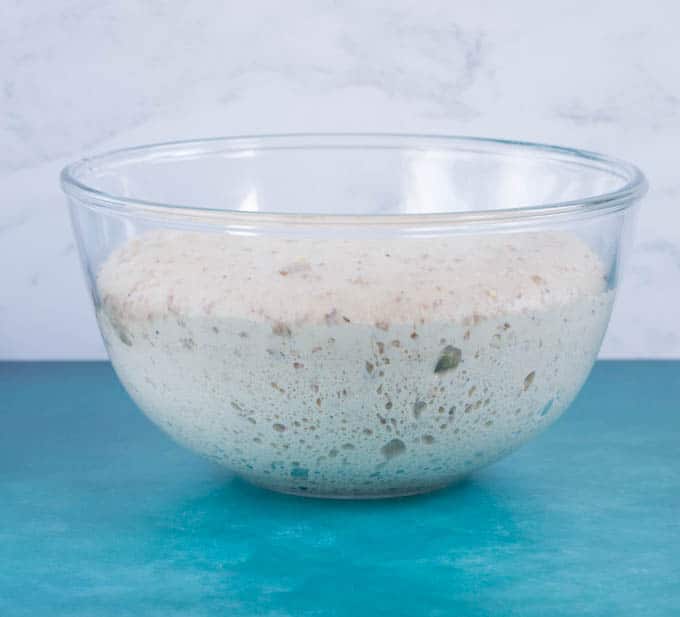
If you have never made milk kefir before, have a look at our post on Getting Started with Milk Kefir. Kefir grains can be bought online, or you can join Facebook kefir groups – they have members who are happy to send grains to new milk kefir enthusiasts.
Once you have the grains, making kefir is easy. Just add the grains to fresh milk and leave to stand for 24 hours or so.
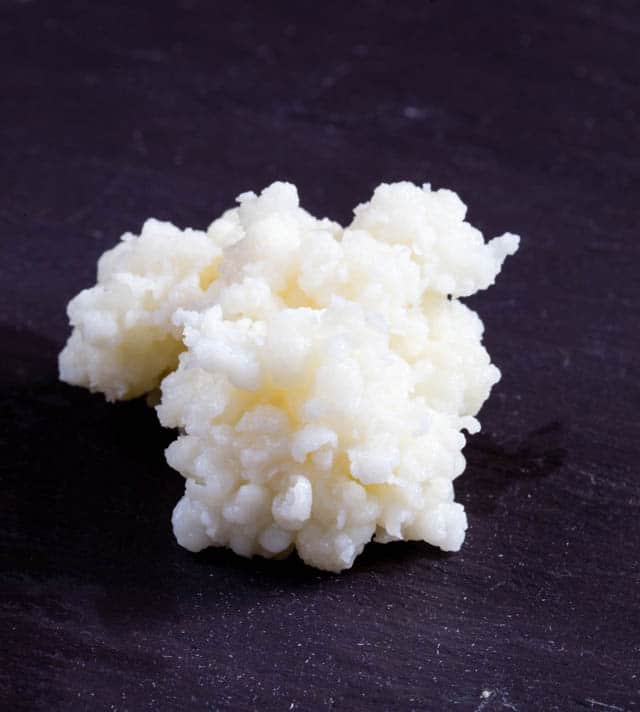
How Do I Make Kefir Bread?
First, mix the flour and salt. I use a combination of strong white and strong brown bread flour. Using strong white bread flour for the bulk of the flour makes for a lighter, tastier loaf.
Second, add the milk kefir. Mix everything together to a rough, shaggy dough.

Third, turn out the dough and give it a few kneads, to make sure that the liquid is evenly distributed through the dough. You don’t need a long knead to develop the gluten, as the long rise allows this to happen naturally.
Fourth, place the dough back in the bowl, cover and leave it to rise until doubled in size. This bulk raise will take time – kefir bread takes longer than my slow rise no knead sourdough. Depending on temperature, I’ve left the dough for 12 hours. You’re looking for the dough to have doubled in volume. This is easy to check if you raise the dough in a straight sided plastic box.
Fifth, form the dough into a loaf and transfer either to a banneton or a greased loaf tin. You need to cover it without touching the top of the dough, leaving space for it to rise. You can use a plastic bag tied around the tin and supported at the edges but I use a shower cap. Leave it to prove until it is well risen and springs back slowly when pushed. Again, this takes longer than sourdough, and much longer than yeasted loaves. You might need to leave the dough for 6 hours at this stage, to get a dough that still feels springy, but not too springy.
Sixth, bake at 180°C for about 35 minutes. When it’s ready, the loaf should sound hollow when you tap it on the bottom. If in doubt give it another 5 minutes.
Finally, allow your kefir bread to cool. Then slice, and enjoy!
Hint and Tips for Kefir Raised Bread
- Timings for first and second rises might vary significantly, depending on temperatures and your kefir. If you place the dough in a straight side plastic box for the first rise, you can easily see when it’s doubled in volume. For the second rise, the loaf is ready to cook when it rebounds slowly when pressed.
- If your kefir is very thick, you may need to substitute some with a little milk or water.
- I made this in a greased loaf tin, but you could also use a cane banneton, well dusted with rye or other gluten free flour for the second rise, then turn the bread out to bake.
- I always grease my loaf tins with butter. I find that I get a far better release of the loaf than when I use oil.
- If you don’t have the time to make this kefir raised bread, but want to incorporate kefir into your baking then make my yeasted kefir bread.
- This bread freezes well – slice, freeze and then toast from frozen.
More Easy Bread Recipes
If you love this try some more bread recipes
And to go on your bread!
Kefir Raised No Yeast Bread
Ingredients
- 250 g strong white bread flour
- 150 g strong brown bread flour
- 1 tsp salt
- 280 ml milk kefir (must be homemade)
Instructions
- In a large bowl, mix the two types of flour and salt. Add the kefir and mix it in until you have a rough, shaggy dough.
- Turn the dough out onto a work surface, and knead briefly until all the kefir is evenly distributed through the dough. As the bulk raising time is so long, a long knead to develop the gluten isn't required.
- Place back in bowl and cover. Leave in a warm (20–25°C) environment until the dough has doubled in size. This may well take several hours.
- Grease a 2lb loaf tin (7" x 4.5" x 3.5"/18 cm x 11 cm x 9 cm) with butter.
- Turn the dough out of the bowl and roll into a sausage. Place in the loaf tin, seam side down. Cover the tin without touching the dough and leaving space for it to rise. We use a plastic shower cap, which is perfect for the job. Leave the loaf to prove. Again, this may take several hours.
- When proved, the dough will spring back slowly when pressed. When you are happy with it, bake at 180°C for about 35 mins. It's done when it sounds hollow when tapped on the bottom.
Notes
- It is essential you use homemade milk kefir for this recipe. The brands of commercial kefir we have tested this with are too finely filtered to carry on fermenting and the bread simply won't rise.
- Kefir bread freezes well. We slice, wrap in a bag, freeze and toast from frozen.
- The use of milk kefir makes this a lovely soft loaf, ideal for sandwiches.
- If your kefir is very thick, you may need to substitute some with a little milk or water.
- I made this in a greased loaf tin, but you could also use a cane banneton, well dusted with flour.
- I always grease my loaf tins with butter. I find that I get a far better release of the loaf than when I use oil.
- This recipe is 4 Weight Watchers Smart Points



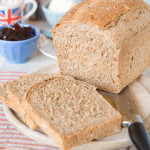
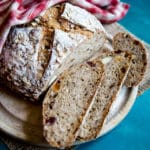

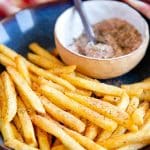
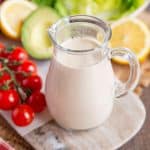

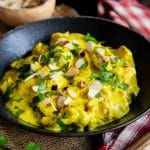




Lu
Does water kefir work?
Helen
Hi Lu, I’ve not tested, but am fairly sure it won’t.
Jo
Very clear easy to follow instructions. I was really pleased with result, I will definitely be making it again. Thanks
Lilly
Thank you so much for this blog post! I used it as inspiration and validation that kefir bread would work. Since I’m using Einkorn flour, however, there’s a big difference in wet/dry ratio, and a few different steps, but it works great! For any Einkorn users out there, my freshly milled (slightly warm) flour, drinks kefir like nobody’s business! For 2 cups of flour, I needed to add 1.75 cups of homemade milk kefir. When I tried with less kefir, the bread turned out heavy and doughy. The secret, I’ve learned, is a wet dough. Then fermenting bubbles can really grow big inside the dough. And like your recipe, I don’t add honey or oil, which I found also weighed down the dough. The lighter the better come baking time! Lastly, Einkorn can’t handle kneading like regular flour. So I knead only 20 times max at the beginning, using a spatula (in a bowl), and then don’t touch it again, putting it away overnight. To bake, I very gently turn the dough into the baking bowl, using a spatula, not hands. Thanks again! Kefir bread is wonderful!
Melissa
Hi! This is a very interesting recipe. I would like to try it. Have you used whey instead of water to thin the kefir milk? I am thinking of ways the whey left from straining could be utilized. Maybe it will taste more tangy??
Helen Best-Shaw
I don’t have leftover whey from kefir making, but if you were staining yogurt to make labneh you could certainly use the whey in the bread.
Olivia
Hi! Can I use organic regular flour in place of the two bread types? I’m slowly reintroducing gluten and would love to use what works for now!
Helen Best-Shaw
Hi Olivia,
You really do need to use strong bread flour to have enough gluten in the bread to get a good rise without the loaf collapsing.
Kathy
Failed completely both times I tried this. It did not rise at all in 12 hours. My house is 77° and kitchen is even warmer. Ended up adding some sourdough starter and kneading it in . Then it rose and I baked it, more than 24 hrs after I started it. I used homemade raw milk kefir, organic bread flour and organic whole wheat bread flour.
Helen Best-Shaw
Hi Kathy,
I am not sure why this happened, especially with homemade milk kefir. We make this bread at least once a month with our kefir and it has never failed
Daniel Smith
If you have a fine mesh that you use for your kefir milk then add some of the kefir grains to your kefir milk to help it rise (most of the yeast is contained in the grains). I blended mine together. The loaf did not rise when using my kefir milk.
Helen Best-Shaw
Hi Daniel, I think must will depend on the character of your grains. we use a regular metal mesh sieve to strain them and the kefir carries on fermenting in the fridge.
I have found over the years that our grains have gone from one big clump to lots of smaller clumps. But with homemade kefir there are generally tiny pieces of grains that break off and go through the sieve.
If your kefir does not carry on fermenting very slowly in the fridge leave some grains in the sieve and bash them through with the back of a spoon